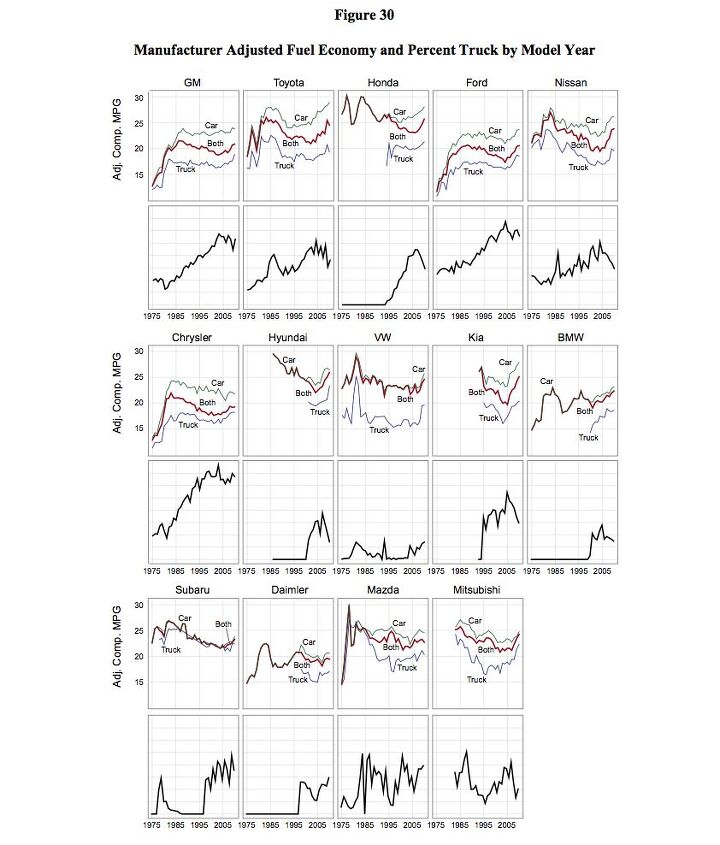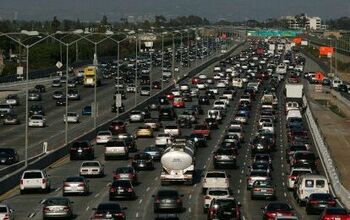Government Investigates The Downsides Of High Fuel Economy Standards
In a supplemental memo related to forthcoming fuel economy standards for the years after 2017 [full doc in PDF here], the EPA has revealed the results of its consultations with stakeholders including the auto industry, and it seems that there are tradeoffs to high standards. The industry’s complaint seems to be that the government has underestimated the impact of higher fuel economy standards on such details as
vehicle performance, utility (e.g., towing capability), and comfort (e.g., noise, vibration, and harshness), the role of competing regulatory or technical requirements (e.g., criteria pollutant and/or safety standards), and assumptions regarding future gasoline fuel properties (e.g., octane levels).
All of which comes with a real price. The government is targeting a 2-6 percent increase in fuel economy standards between 2017 and 2025, which amounts to a range of 47-62 MPG. The NHTSA/EPA estimates show that this level of increase will cost automakers between $770 and $3,500 per vehicle to meet, but automakers insist that these estimates are too low. And apparently, the government takes these concerns seriously enough to blow its end-of-November deadline for narrowing the range of possible standards. At the top of the list of issues for study: the age-old trade-off between efficiency and safety.
The memo notes
NHTSA and EPA will conduct an analysis of the effects of the proposed standards on vehicle safety, including societal effects. CARB is undertaking and coordinating with EPA and NHTSA on a study of how a future vehicle design that incorporates high levels of mass reduction complies with vehicle safety standards and voluntary safety guidelines. NHTSA is also initiating a new study of the feasible amount of mass reduction based on a mid-size passenger car platform, and the effects of several advanced mass reduction design concepts on fleet safety. The NHTSA studies are being coordinated with EPA, DOE, and CARB.
This is a battle TTAC has longed to see for some time: the efficiency-first crusaders championing mass-reduction versus the safety-first crusaders championing the rolling bunker mentality. Both sides are equally self-righteous about their pet causes, and forcing the two to come to a compromise will be an important step. But the issue of cost will be one of the toughest points of contention in the whole post-2017 CAFE debate. Will the government be harassed into more giveaways to help automakers reach impossibly high standards, will consumer incentives help the CAFE medicine go down, will standards be moderated, or will the EPA and NHTSA simply defer to a proposed gas tax hike to take care of emissions? Either way, someone will have to pay t he high price of fuel efficiency.
More by Edward Niedermeyer
Latest Car Reviews
Read moreLatest Product Reviews
Read moreRecent Comments
- Formula m For the gas versions I like the Honda CRV. Haven’t driven the hybrids yet.
- SCE to AUX All that lift makes for an easy rollover of your $70k truck.
- SCE to AUX My son cross-shopped the RAV4 and Model Y, then bought the Y. To their surprise, they hated the RAV4.
- SCE to AUX I'm already driving the cheap EV (19 Ioniq EV).$30k MSRP in late 2018, $23k after subsidy at lease (no tax hassle)$549/year insurance$40 in electricity to drive 1000 miles/month66k miles, no range lossAffordable 16" tiresVirtually no maintenance expensesHyundai (for example) has dramatically cut prices on their EVs, so you can get a 361-mile Ioniq 6 in the high 30s right now.But ask me if I'd go to the Subaru brand if one was affordable, and the answer is no.
- David Murilee Martin, These Toyota Vans were absolute garbage. As the labor even basic service cost 400% as much as servicing a VW Vanagon or American minivan. A skilled Toyota tech would take about 2.5 hours just to change the air cleaner. Also they also broke often, as they overheated and warped the engine and boiled the automatic transmission...


































Comments
Join the conversation
Most people's tiny minds can't get their head around the fact that wasting energy and killing each other on the roads is a HUGE cost to a nation. In the USofA it's a particularly difficult problem because pure selfishness (dressed up as "liberty") is reversing the gains made in decades past to create a middle-class. A little more macro thinking needs to be explained to the micro-minded. Otherwise, China wins (it has already, but hey...)
And projecting geeber's logic would show that we'd be safer blasting around at 120mph in bus-sized cars. Taken the other way, being a pedestrian is obviously extremely unsafe. Tiny minds are always trying to repeal the laws of physics.